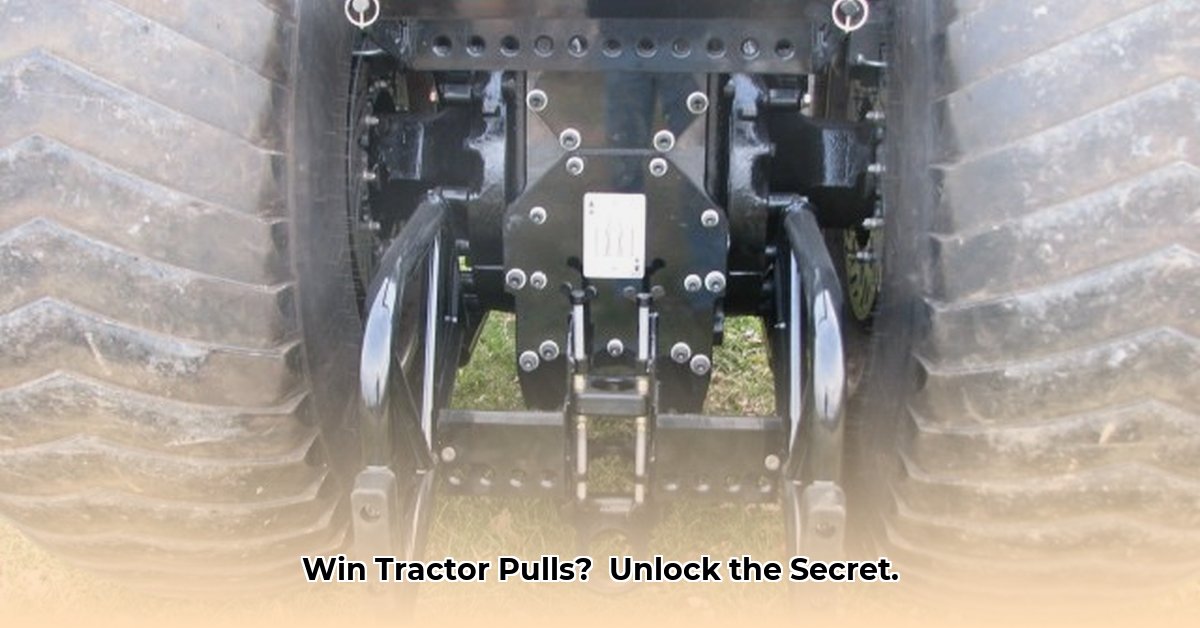
Let's talk winning. In tractor pulling, raw horsepower is only half the battle. The other half? A meticulously engineered hitch. Think of the hitch as the critical link between your tractor's engine and the sled – a well-designed hitch maximizes power transfer, ensuring peak pulling efficiency. Get it wrong, and you're losing potential, traction, and maybe even risking a dangerous accident. This guide provides the actionable steps to design a winning hitch. For more detailed information, check out this helpful resource.
Hitch Geometry: Finding the Optimal Setup
Effective hitch design isn't about luck; it's about precision. The key lies in finding the perfect balance. Let's look at two crucial geometric aspects: height and distance from the rear axle.
Hitch Height: Balancing Leverage and Stability
Hitch height significantly impacts leverage and stability. Too low, and you lose leverage; too high, and you risk a dangerous forward tip. Always begin with your manufacturer’s recommended height, using it as a baseline for experimentation within competition rules. Observe how height changes affect weight distribution and traction. Meticulous record-keeping is crucial.
Hitch Length (Distance from Rear Axle): The Risk/Reward Equation
Some pullers extend the hitch for added leverage, believing it boosts pulling force. However, this increases rollover risk dramatically. A longer hitch amplifies strain on the rear, compromising stability. The optimal length maximizes leverage without compromising safety. It’s a delicate balancing act. Focus on finding the maximum advantage you can safely manage.
Weight Distribution: The Seesaw Analogy
Imagine a seesaw: your tractor on one side, the sled on the other, with the hitch as the pivot point. Even weight distribution keeps your front wheels firmly planted, maximizing traction. Too much weight on the rear lifts the front, reducing traction. Too little rear weight reduces the tractor’s “bite.”
A well-designed hitch manages this balance effectively. Adjust hitch height and position, strategically adding weight to the front or rear as needed. Meticulous record-keeping during test runs is invaluable, revealing exactly how small changes impact performance.
Safety First: An Unwavering Priority
Safety isn’t optional—it's paramount. Improper modifications risk serious accidents, including potentially devastating rollovers. Always prioritize safety:
- Thorough Inspection: Before every pull, meticulously inspect every bolt, weld, and connection. Don’t rush. Don’t cut corners. Double-check everything.
- Rule Adherence: Competition rules are designed to ensure safe practices. They are not suggestions—they are vital guidelines. Ignoring them is unsafe and could lead to disqualification.
- Understanding Limitations: Know your tractor's capabilities and your own driving skills. Pushing either too far carries serious consequences. Gradual, cautious experimentation is key.
Optimizing Your Hitch Design: A Step-by-Step Guide
This practical approach combines careful experimentation and data analysis:
- Establish a Baseline: Begin with your tractor's factory hitch settings. This establishes a known starting point for comparison.
- Incremental Adjustments: Make small, controlled adjustments to hitch height and length. Document every change and its effect on traction and weight distribution.
- Traction Analysis: Observe your tractor's traction meticulously. Note any wheel slip or front-end lift. These are critical indicators of an unbalanced system.
- Weight Experimentation: Add weight to the front or rear (using approved weights) to fine-tune weight distribution. Observe precisely how this impacts pulling ability.
- Iterative Refinement: This is a continuous process. Experimentation, analysis, and refinement are what make your design progressively better. There's no magic bullet – only careful, systematic improvement.
Competition Rules: Know the Regulations
Competition rules strictly limit hitch modifications. These rules are vital for fair play and safety. Always consult the specific rules before making any changes. These rules often include critical details on minimum hole dimensions and their placement. Neglecting this can result in penalties.
The Future of Tractor Pulling Hitch Design
Ongoing research and development, including advanced materials and computer simulations, suggest even more sophisticated hitches are on the horizon. We anticipate seeing more customized designs for specific tractor models and classes, prioritizing efficiency and safety. These developments aim to help competitors refine their setups and achieve peak performance without raising risk profiles.
Remember, your perfect hitch setup is unique to your tractor, driving style, and competition rules. Embrace the experimental process, prioritizing safety throughout, and prepare to pull your way to victory! A winning hitch isn’t found; it’s built through careful analysis and incremental improvement.